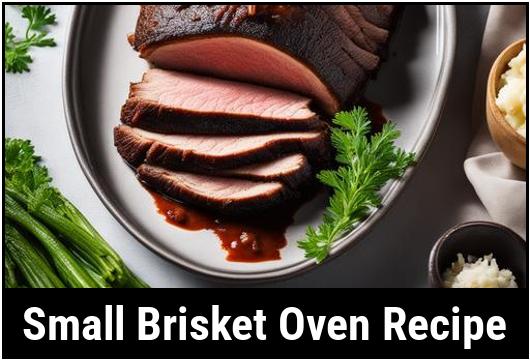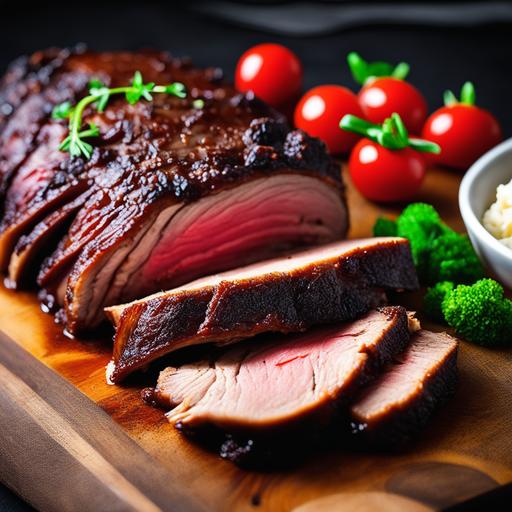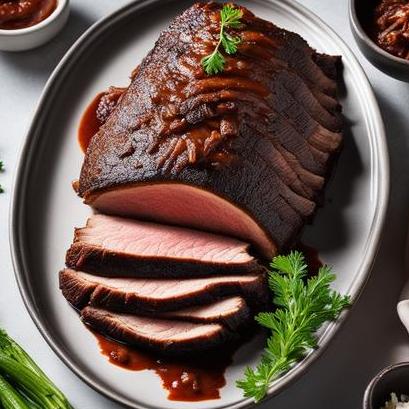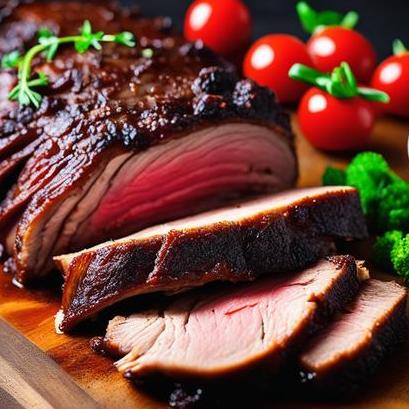
Small Brisket Oven Recipe: A Delectable Delight
Imagine sinking your fork into a succulent, tender piece of small brisket that has been slow-roasted to perfection in the oven. The aroma wafting through your kitchen, the anticipation building with each passing minute, and the knowledge that you are about to indulge in a delightful culinary experience – all of this awaits you as you embark on your small brisket oven recipe journey.
Understanding the Food Science behind Brisket
Before we dive into the intricacies of preparing and cooking a small brisket in the oven, let’s take a moment to understand the food science that makes this cut of meat so unique and flavorful. Brisket comes from the breast or lower chest of the cow, and it is a heavily exercised muscle. This constant movement leads to a high concentration of connective tissue and collagen throughout the meat.
When exposed to low and slow cooking methods, such as oven roasting, the connective tissues slowly break down, resulting in a tender, juicy, and melt-in-your-mouth brisket. The collagen transforms into gelatin, providing a buttery texture and adding a depth of flavor that is unrivaled.
Selecting the Perfect Small Brisket
To ensure a memorable small brisket oven experience, it is crucial to start with a quality piece of meat. When choosing a small brisket, look for one that has good marbling – streaks of fat within the muscle. This marbling contributes to the tenderness and juiciness of the final dish.
Another factor to consider when selecting your small brisket is the thickness of the fat cap. The fat cap protects the meat during the cooking process, keeping it moist and adding flavor. Opt for a brisket with a fat cap that is even and approximately 1/4 to 1/2 inch thick.
Remember, it is essential to buy from a reputable butcher or supplier who guarantees the freshness and quality of their meat.
Cleaning and Preparing the Small Brisket

-
Begin by rinsing the small brisket under cold water to remove any residual blood or impurities. Pat it dry with paper towels.
-
Use a sharp knife to trim any excess fat from the surface of the meat, leaving a thin, even layer that will enhance the flavor and juiciness of the brisket.
-
Score the fat cap in a crisscross pattern, being careful not to cut into the meat itself. This will allow the seasoning to penetrate and infuse the brisket.
-
Season your small brisket liberally with a dry rub of your choice. Experiment with flavors like smoked paprika, garlic powder, onion powder, black pepper, and brown sugar to create a unique and tantalizing blend. Ensure you apply the rub evenly on all sides of the brisket.
Tips for Achieving Brisket Perfection

-
Allow your seasoned small brisket to rest at room temperature for about 30 minutes before cooking. This will help the meat cook more evenly.
-
Preheat your oven to 275°F (135°C) for a slow and steady cooking process that results in tender, juicy meat.
-
Use a roasting pan or a heavy-duty, oven-safe dish that is large enough to accommodate your small brisket comfortably. The pan should have at least 2-inch sides to prevent any juices from spilling over.
-
Consider laying a bed of sliced onions, carrots, and celery in the roasting pan before placing your small brisket on top. These aromatic vegetables will add flavor and moisture to the final dish.
Achieving the Perfect Brisket Doneness

Determining the doneness of your small brisket can be a daunting task, but fear not! Follow these essential tips to ensure excellent results:
-
Internal Temperature: Invest in a reliable meat thermometer. When the thickest part of the small brisket reaches an internal temperature between 195°F (90°C) and 205°F (96°C), it is ready. At this point, the collagen has melted, and the brisket is fork-tender.
-
Probe Test: If you prefer a more traditional method, use a toothpick or meat probe to check the tenderness. When inserted into the meat, it should glide smoothly with little resistance.
-
Visual Clues: The meat should have a dark, rich outer bark or crust, which adds texture and flavor. The fat cap should be rendered and caramelized, enhancing the overall taste experience.
Remember, brisket is forgiving, and slightly overcooking it can lead to enhanced tenderness. However, avoid overcooking to the point where the meat becomes dry and loses its succulence.
Embrace the Art of Brisket Variations

Traditional small brisket oven recipes often call for simple seasonings and slow cooking, but don’t stop there! Embrace your creativity and experiment with various flavor profiles and cooking techniques.
-
Smoky Barbecue Brisket: Enhance your small brisket by infusing it with the smoky goodness of classic barbecue flavors. Brush the meat with your favorite barbecue sauce before placing it in the oven, then baste periodically to build a luscious glaze.
-
Mexican-inspired Brisket: Give your small brisket a vibrant twist by incorporating Mexican spices. Rub the meat with a combination of chili powder, cumin, oregano, and a hint of lime zest. Serve it with warm tortillas, pico de gallo, and a squeeze of fresh lime juice for an unforgettable taco night.
-
Asian-inspired Brisket: Elevate your small brisket with Asian flavors by marinating it in a combination of soy sauce, ginger, garlic, and a touch of honey. Slow-cook the brisket until it is tender, then slice it thinly and serve it over steamed rice or in lettuce wraps for a delightful fusion experience.
The variations are endless! Allow your taste buds and culinary imagination to guide you on a journey of flavor exploration.
Indulge in the Small Brisket Oven Recipe
Now that we have covered the essentials, it’s time to delve into the comprehensive small brisket oven recipe. Follow these step-by-step instructions to create a memorable culinary masterpiece:
Ingredients:
-
1 small brisket (approximately 4-5 pounds)
-
Dry rub of your choice
-
Aromatic vegetables for the roasting pan (optional)
Instructions:
-
Preheat your oven to 275°F (135°C).
-
Prepare your small brisket by cleaning, trimming, and seasoning it with a generous amount of dry rub. Ensure the seasonings coat all sides of the brisket.
-
If desired, lay a bed of sliced onions, carrots, and celery in the roasting pan, creating a flavorful base for the brisket.
-
Place the seasoned small brisket fat side up in the roasting pan. If using aromatic vegetables, position the brisket on top of them.
-
Cover the roasting pan tightly with foil to seal in the moisture and flavors.
-
Transfer the roasting pan to the preheated oven, allowing the small brisket to cook slowly for approximately 1 hour and 15 minutes per pound. This translates to a total cooking time of 5 to 6 hours for a 4-5 pound brisket.
-
After the prescribed cooking time has elapsed, carefully remove the foil and check the internal temperature or tenderness using the methods highlighted above.
-
Once the small brisket reaches the desired doneness, remove it from the oven and let it rest, loosely covered, for at least 30 minutes. This resting period will allow the juices to redistribute, resulting in a moist and flavorful final product.
-
Slice your small brisket against the grain to ensure tenderness and serve it alongside your favorite side dishes. Mashed potatoes, roasted vegetables, or creamy coleslaw are all excellent accompaniments to highlight the bold flavors of the brisket.
Conclusion
Preparing a small brisket in the oven is a culinary journey that combines the art of cooking with the science of food. By understanding the unique properties of brisket, selecting the perfect piece of meat, and employing essential cooking techniques, you will undoubtedly achieve tender and delectable results.
Embrace the versatility of brisket by experimenting with various seasonings, flavors, and cooking styles. Let your imagination run wild as you create personalized variations that suit your palate and delight your senses.
So, gather your ingredients, preheat that oven, and embark on a small brisket oven adventure that will transport you to a realm of gastronomic pleasure. Prepare to savor each bite, and bask in the satisfaction of knowing you have mastered the art of small brisket perfection.
Sources
FAQS On Small Brisket Oven Recipe
What Is The Best Cut Of Brisket To Use For A Small Brisket Oven Recipe?
When making a small brisket in the oven, it is best to use the flat or first cut of brisket. This cut is leaner and more tender compared to the point cut, making it ideal for oven cooking.
How Long Should I Cook A Small Brisket In The Oven?
The cooking time for a small brisket in the oven depends on the weight and desired level of doneness. As a general guideline, you should cook a small brisket at 325°F (163°C) for approximately 30 minutes per pound. However, it is always best to use a meat thermometer to ensure the internal temperature reaches 195°F (90°C) for a tender and juicy brisket.
Should I Marinate The Small Brisket Before Cooking It In The Oven?
Marinating the small brisket before cooking it in the oven is a personal preference. While marinating can add flavor and tenderness, the lean cuts of brisket used for oven cooking may not require it. However, if you want to infuse additional flavors, you can marinate the brisket overnight in a mixture of your choice, such as a combination of Worcestershire sauce, soy sauce, garlic, and spices.
Can I Use A Slow Cooker Instead Of An Oven For A Small Brisket Recipe?
Yes, you can use a slow cooker to cook a small brisket as an alternative to using an oven. Simply place the brisket in the slow cooker along with your choice of liquids and seasonings, and cook on low heat for 8-10 hours or on high heat for 5-6 hours. This method will result in a tender and flavorful brisket as well.
How Should I Slice A Small Brisket After It Is Cooked In The Oven?
After cooking a small brisket in the oven, it is important to let it rest for at least 15-20 minutes before slicing. This allows the juices to redistribute and ensures a moist and tender finished product. To slice the brisket, use a long, sharp knife and cut against the grain for maximum tenderness. The grain refers to the lines running through the meat, so simply slice perpendicular to those lines.


